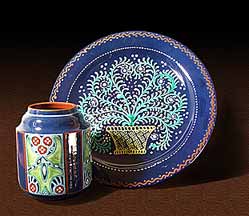
Karlsruhe Plate and Pot

Karlsruhe Plate and Pot
Karlsruhe Plate and Pot
Karlsruhe Majolika Manufaktur
Majolika-Manufaktur was set up at Karlsruhe in south-west Germany in 1901 in a pottery built by Grand Duke Friedrich I. The raison d'etre for the pottery was the desire of two German pictorial artists, Wilhelm Süs and Hans Thoma, to produce ceramics in the Italian Renaissance style.
Towards the end of the decade a style had developed with designs, often churubim, on a blue background. Domestic and decorative wares were produced using designs by various artists, and the company started the production of architectural and outdoor ceramics.
In the following years the pottery passed through various hands, at one time being occupied by Villeroy and Bosch, the premises being owned by the state of Baden. In 1927 the word 'Staatliche' was added to the name to indicate state ownership. Top designers of the day were employed, notably Ludwig König and Max Läuger.
The factory was badly damaged by bombs in 1944, and was not back into full-time production of decorative goods until the 1950s, after which business resumed much as in pre-war days with company-employed and freelance designers. Examples of the company's products can be seen at the Badisches Landesmuseum in Karlsruhe.


